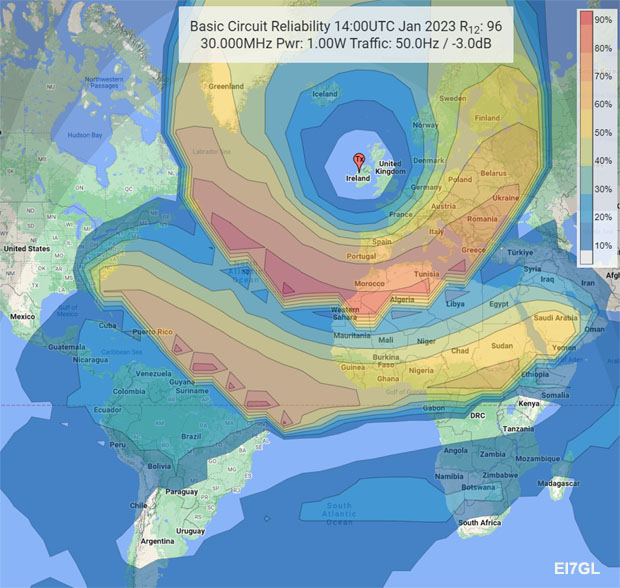First a disclaimer! I really don't have much interest in DX on the HF bands, DX-peditions or the HF bands in general but I have seen a lot of 'chatter' about predictions for propagation for the 3Y0J expedition on Bouvet Island during February 2023. I decided to have a look at what propagation on 28 MHz might be like and I will concentrate on Europe and North America.
If you want to see a video about general HF propagation then have a look at this previous post with a video from OH6BG.
Bouvet Island is a small island in the South Atlantic. The 3Y0J team plan to operate from a location 80m above sea level at Cape Fie at the south-east tip of the island.
The one thing to take away from this image is that there are mountains that are about 600-700m high about 4-5 kms from the 3Y0J site and these will impact the signal on the 10m band. It might be fine for the lower HF bands like 40-17m where there may be much higher level angles of radiation involved for propagation but the mountains will block some of the low angle signals required for 28 MHz. This is especially true for North America. More on that later.
This is the Great Circle map for Bouvet Island. Starting from the west... 270 degrees...and going clockwise.
North and South America are to the north-west and in the direction of the mountains... not great.
Europe to the north is blocked somewhat but is much better than North America. Japan has a sea path. Australia also has a sea path and it's likely that VK6's in Perth will fare better than their VK2,3 & 4 colleagues. The required path for some place like Sydney requires the signal to travel further south and there may be no propagation on the higher HF bands. New Zealand is at the other side of the Antarctic so that will be a challenge.
C- 291 deg - Florida and Sao Paulo. A 6 degree obstruction.
D - 305 deg - New York. About 6.5 degrees.
E - 323 deg - Newfoundland. Starting to get a bit easier but still a 5 degree obstruction.
F - 350 deg - Lisbon. Now down to just under 4 degrees. Better but still not great.
G - 357 deg - London. About 3.5 degrees. I have a local hill here which is about this level. I can hear stations on 28 MHz coming in from that direction but the performance is a lot worse compared to someone who doesn't have this obstruction
H - 6 deg - Berlin. Just below 3 degrees.
I - 11 deg - Warsaw. Down to 2 degrees. Getting down to a level where I'd start considering it being not too much of an obstruction on 28 MHz.
28 MHz Predictions - Feb 2023... For the 10m predictions, I used 100-watts from a CW station ...a typical signal for an average station and not someone with beams, towers and amplifiers. 3Y0J will of course be using much more than this but these are the kind of signals they will be listening for.
10:00 UTC : Band is just getting going with a modest signal into Europe. The first F2 hop puts a big signal into South Africa. You can see the second F2 hop over the centre of Africa. Note that places like Greece and Sicily are in a bit of a skip zone.
12:00 UTC : The propagation moves further west. The 4th F2 hop improves signals across the centre of Europe. Note again that skip zone between the 3rd and 4th hops in the south of Europe. The path just opens to the the east coast of the USA.
16:00 UTC: The one thing to note here is the sun setting in the east of Europe. This creates a peak in signals at 28 MHz as it passes. It's a bit like a surfer waiting to catch that big wave. What's good about this is that it is confined to a relatively small geographic area.
For example, a station in Warsaw at sunset should see a peak in signals and is competing in the pile up with stations in the east of Europe as opposed to all of Europe.
There are signals in the south of Europe but it's still in a bit of a skip zone. Most of the USA is now covered.
18:00 UTC : The sunset peak reaches western Europe. It's also the best time for stations in southern Europe but there's plenty of competition from stations to the north. Signals are improving in North America.
20:00 UTC : The propagation reaches North America but the sun also starts setting in Bouvet. The one thing to notice here is that there will be skip zones. The signal could be reasonable in New York and weak in Chicago.
Caveats... It should also be noted that this is just a prediction!
The 3Y0J team is there for most of February and the sunrise and sunset times will change a good bit over that period.
The predictions above are based on a station on a flat site with a flat horizon. The mountains and hills will block the low angle signals in certain directions and the more northern parts of where the peaks are shown are likely to be missing.
Top Tip!... Regardless of what band you're on, look for sunrise and sunset times for Bouvet and your own location, This is especially true for stations in Europe and North America.
As the sun sets, the layers in the ionosphere can get tilted and a high angle signal going over those obstructions on the horizon can get turned into a low angle signal to be propagated forward.
Bottom Line... If you're in North America and on any of the bands from 30m to 10m then look at the sunset time in Bouvet.











































